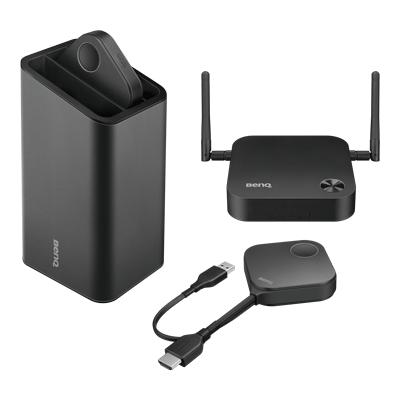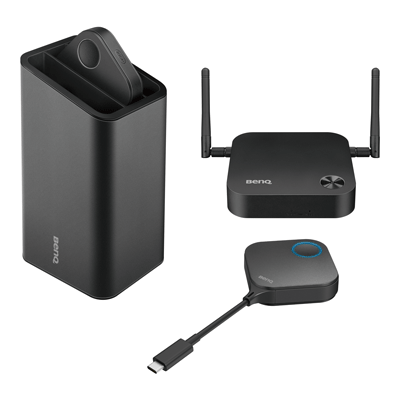Interested in Buying Screenbeam?
- BenQ
- 2025-09-25

The ActionTec ScreenBeam has been a low-cost wireless presentation system that utilizes multiple streaming technologies over the company network in a meeting room or classroom. ScreenBeam is produced by ActionTec, a privately held company that also makes home networking products, and is less expensive than most other systems. So how does the ScreenBeam compare to other popular wireless presentation systems? We will look at popular options to the ScreenBeam from Barco and BenQ. To evaluate these ScreenBeam 1100 alternatives, we will look at these factors:
- Are they easy to set up?
- Can visitors use them?
- How well do they support 4K interactive displays used in meeting rooms and classrooms?
- What do they cost?
What are the best ScreenBeam Alternatives?
BenQ InstaShow S WDC15
According to Gagagadget.com, the BenQ InstaShow is the best wireless presentation system available today in 2025. InstaShow series uses a simple USB-C button connection, enabling a single tap to wirelessly mirror the screen, and easily supports 4K UHD content as well as the ability to wirelessly control your notebook from an interactive display for annotations and changing slides. The BenQ InstaShow WDC15 is unique in that it is a hardware-only solution, so there is no application or networking required to set up and use the system. The InstaShow buttons are highly secure and encrypt all the transmissions to ensure wireless information is not seen or recorded outside the room.

Barco ClickShare C-10
The Barco ClickShare was one of the very first wireless presentation systems available and is very popular, especially for corporations. Like the InstaShow, it uses a button system to connect to the notebook, which simplifies the connection.
When you connect the button to your notebook, the Clickshare button has a proprietary app that is loaded onto the notebook to transmit the presentation to the receiver and requires some network configuration for a typical installation. While the system can support 4K output and touch back, the button takes a snapshot of your notebook screen to transmit to the screen, which can reduce the resolution quite a bit depending on what notebook you’re using. Like the InstaShow, you can control your notebook from an interactive display, and all the transmissions are encrypted.

How easy are they easy to set up?
No one likes having to spend hours configuring networks and installing software to get a wireless presentation system to work. Here is how the three different wireless presentations rank in terms of how easy it is to set up and install in a typical company meeting room or classroom.
BenQ InstaShow WDC15
The InstaShow WDC15 is designed to install right out of the box in just a few minutes without the need for IT support. There is no network configuration needed – or software deployment required. Simply connect to the display’s HDMI port, and if you have an interactive display like the BenQ Board, connect to the USB touch port on the display. The receiver is powered by a USB-C port, so if you have one available on your display (the BenQ Board has two) you can use this to power the display directly and avoid having to run another power cable. The button is pre-paired, so put it on the meeting room table, and you are ready to start presenting.
ScreenBeam 1100
Because the ScreenBeam system typically uses the enterprise or campus Wi-Fi network to transmit the video to the ScreenBeam receiver, the setup and implementation is more complicated than InstaShow. The ScreenBeam needs about a dozen ports configured on your network and recommends IT managers use the Quality of Service (QoS) adjustments to prioritize ScreenBeam network traffic and offers the following requirements and recommendations for optimal performance. This is because to transmit 4K video to the screen, you’ll need up to 50mbps of bandwidth on your network. 1080p resolution requires about 25mps, and the quality of the video can be impacted if there is too much network traffic. While ScreenBeam can use Miracast and Airplay, they also have their own app that is loaded on the notebook to enable certain features to be used.
The Barco ClickShare also requires you to configure your network to accommodate the device unless you want to run it in a temporary mode. Like ScreenBeam, this involves configuring over a dozen network ports. Barco also has an app that needs to be loaded on the system, and deployed to meeting room users, This app uses the notebook’s system resources to perform some of the functions needed to use the ClickShare system. This can pose a problem for customers who have “locked down” notebooks who may require IT support or permission to load software onto their notebooks.
Because the BenQ InstaShow does not require any software applications or special network configuration, it is easier and faster to install without IT support. The ScreenBeam and ClickShare are more complex and will typically need IT support to ensure the network ports are properly configured, and that the network is secure from vulnerabilities.
Can visitors use them?
BenQ InstaShow
ScreenBeam relies almost entirely on the Miracast Peer to Peer networking protocol or the Apple AirPlay protocol to work. While this removes the need for a proprietary app such as the Barco ClickShare app, it can impact usability. For example, Miracast only allows two devices to connect at once, and the presenter needs to log onto the same network that the ScreenBeam is using to connect to the receiver.
No software is needed to be installed on the visitors or employee notebook. The button will also work with any HDMI device output, enabling it to work with nearly any device such as a document camera, video conferencing system, or media player. An HDMI cable is included with the system, eliminating the need for adapters. The whole process takes about ten seconds – which is why Toyota uses the InstaShow to keep their meetings running on time. The InstaShow button supports wireless touch back on interactive displays with both PC’s and Mac’s.
ScreenBeam 1100
ScreenBeam relies almost entirely on the Miracast Peer to Peer networking protocol or the Apple Airplay protocol to work. But if you have VPN software or certain levels of security protection, it won’t work, so you’ll have to ask them to disable some of their security protections. Visitors may also have to update their graphics or other drivers for the system to work, which can eat up time in the meeting and break the flow of the conversation.
Like the InstaShow, visitors connect the ClickShare button to their notebook to start presenting. But the system relies on the ClickShare app running on the notebook to enable the buttons to transmit to the receiver, so the button will download the app onto the visitor’s notebook automatically. If the system is locked for security, this could be a problem and require the visitor to use other methods like Google cast. Note that the Clickshare button does not support Chromebooks.
While both the InstaShow and ScreenBeam enable employees and visitors to do wireless screen mirroring without loading an application on their device, the InstaShow’ s button architecture makes it easy to connect without having to disable security features, install software, and log onto new networks for the visitor.
Support for 4K UHD Interactive displays
The ability to support the latest advanced displays is a critical element of choosing the ideal system for wireless screen mirroring in office environments. Traditional low-resolution projectors are rapidly being replaced by 4K UHD flat panels and interactive displays that enable a presenter to control and annotate their presentation by writing or gesturing on the screen, then sending the annotated file directly to the meeting attendees using a QR code. How well do these wireless presentation systems work with this technology?
ScreenBeam 1100
ScreenBeam transmits the 4K UHD signal over the company network and will require about 50mps of bandwidth for every display. This means that if there is insufficient bandwidth or the ScreenBeam traffic is lower priority, it could impact the frame rate and smoothness of the video. While Miracast supports interactive displays touch back, Airplay doesn’t, so Mac users would download the ScreenBeam app and log into the network to use this feature.
BenQ InstaShow WDC15
The BenQ InstaShow WDC15’s USB-C button has native 4K UHD support and wireless USB touch support built in to connect to any 4K UHD interactive display. Since it doesn’t require any software or rely on your company network, it can display smooth 4K UHD video with nearly instant response. The button also is the only one to support HDCP content from any source, including Blu-Ray players, media players, and digital cameras using the HDMI connector.
The ClickShare C-10 receiver has the ability to support wireless 4K content, but if you use the button, the resolution will be limited to your notebook screen. For example, the top selling Dell business notebook in 2025 only has a screen with 2 million pixels, which is much lower than the 8.3 million pixels on a 4K UHD meeting room or classroom display. The unit also will support wireless touch back via the USB port like the InstaShow.
How Much do they cost?
We’ll detail the purchase prices and soft costs for each product so you can use the Gartner TCO Calculator to determine the total cost of ownership to calculate the costs your organization, such as the soft cost for IT support to set up the units, deployment of software to organization devices, training, and software/driver update maintenance.
| BenQ InstaShow WDC15 | ScreenBeam 1100 | Barco ClickShare C-10 | |
|---|---|---|---|
Simple Setup | BenQ InstaShow WDC15 Yes | ScreenBeam 1100 No- Requires Network port configuration | Barco ClickShare C-10 No-Reuires Network port configuration |
No Software Required | BenQ InstaShow WDC15 Yes | ScreenBeam 1100 Some features cannot be used without app | Barco ClickShare C-10 No-app is required, extra driver for extended desktop |
Purchase Price | BenQ InstaShow WDC15 $799 | ScreenBeam 1100 | Barco ClickShare C-10 |
Button Holder | BenQ InstaShow WDC15 Included | ScreenBeam 1100 N/A | Barco ClickShare C-10 $95 |
Annual subscription required | BenQ InstaShow WDC15 No | ScreenBeam 1100 No | Barco ClickShare C-10 No |
Conclusion – Best Alternative to ScreenBeam?
The InstaShow WDC15 and Barco C-10 are the best alternatives to ScreenBeam since the simplicity of using buttons eliminates the risk of having meeting time potentially wasted by incompatible drivers, security software and the possibility of network performance limitations for a presentation. The button also ensures that the presenter can easily connect to the display and use the touchback features regardless of what kind of notebook they are using. The BenQ InstaShow is the only alternative that offers HDCP content support and ensures that a true 4K resolution to enable you and your visitors to put their best foot forward in their presentations. If you’re looking for a proven alternative that is simple to set up and use without a lot of drama, then drop us a like to try one for free at no risk to you.



